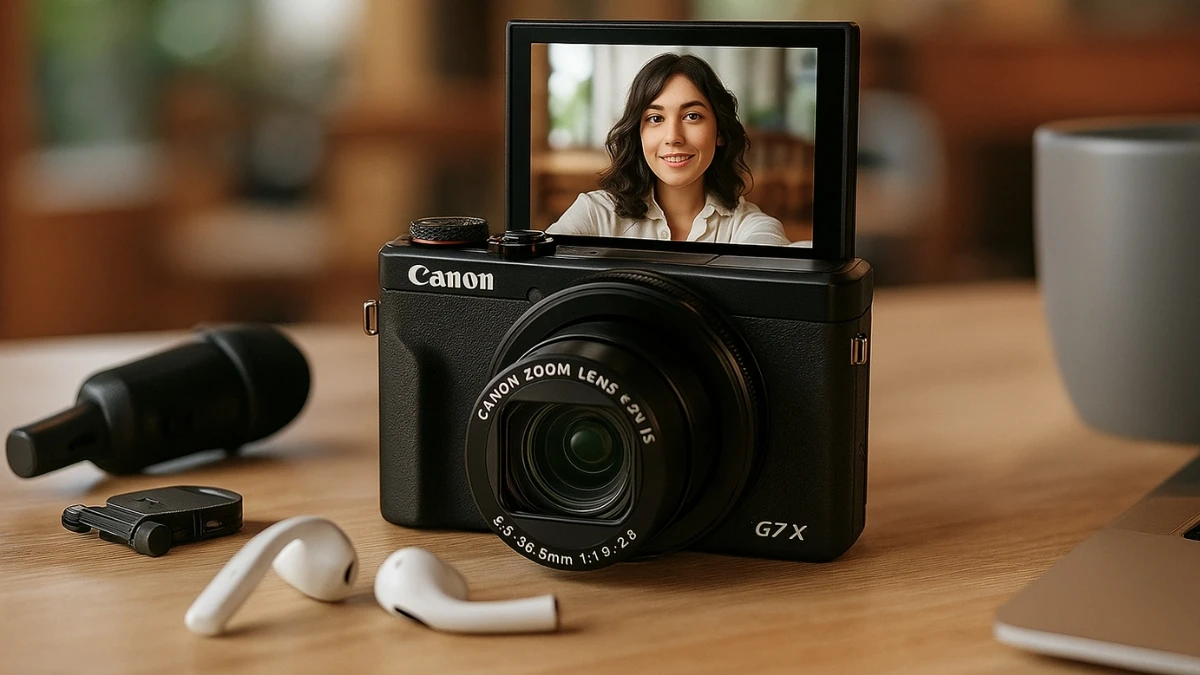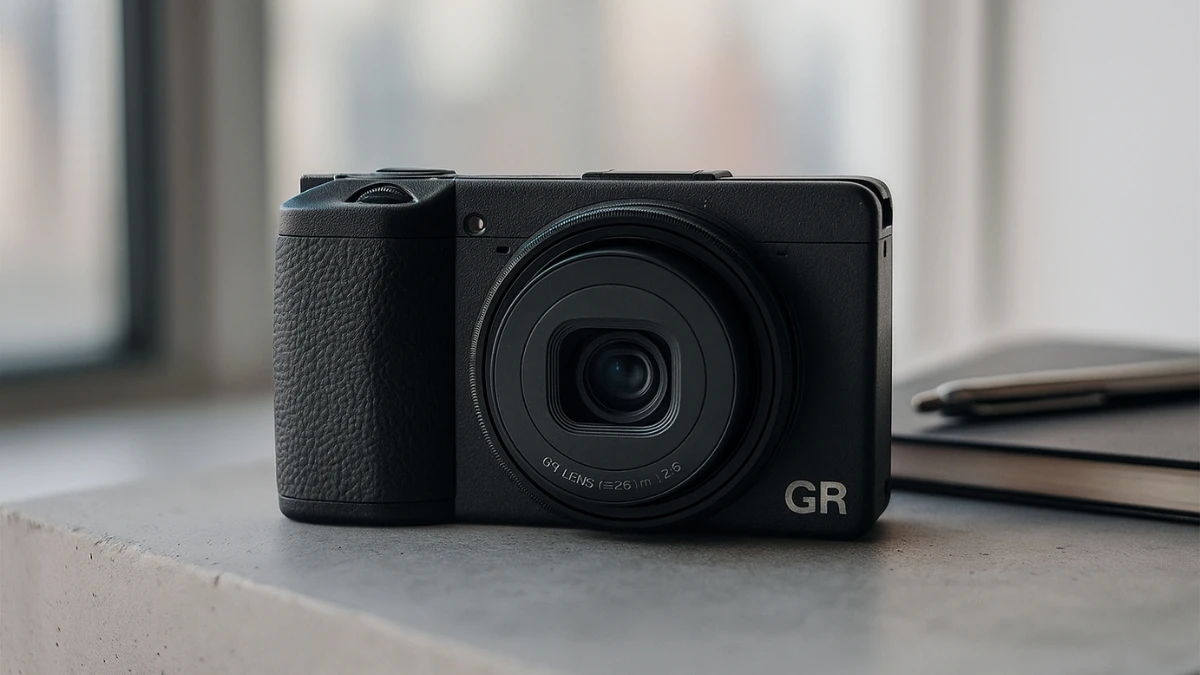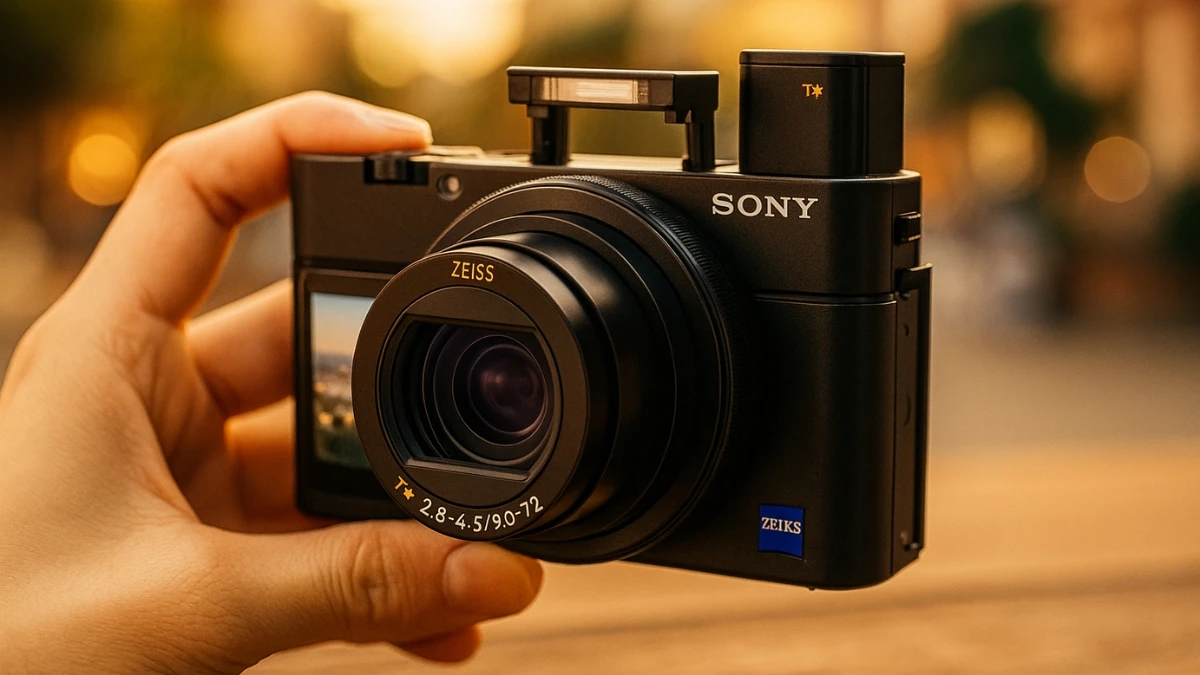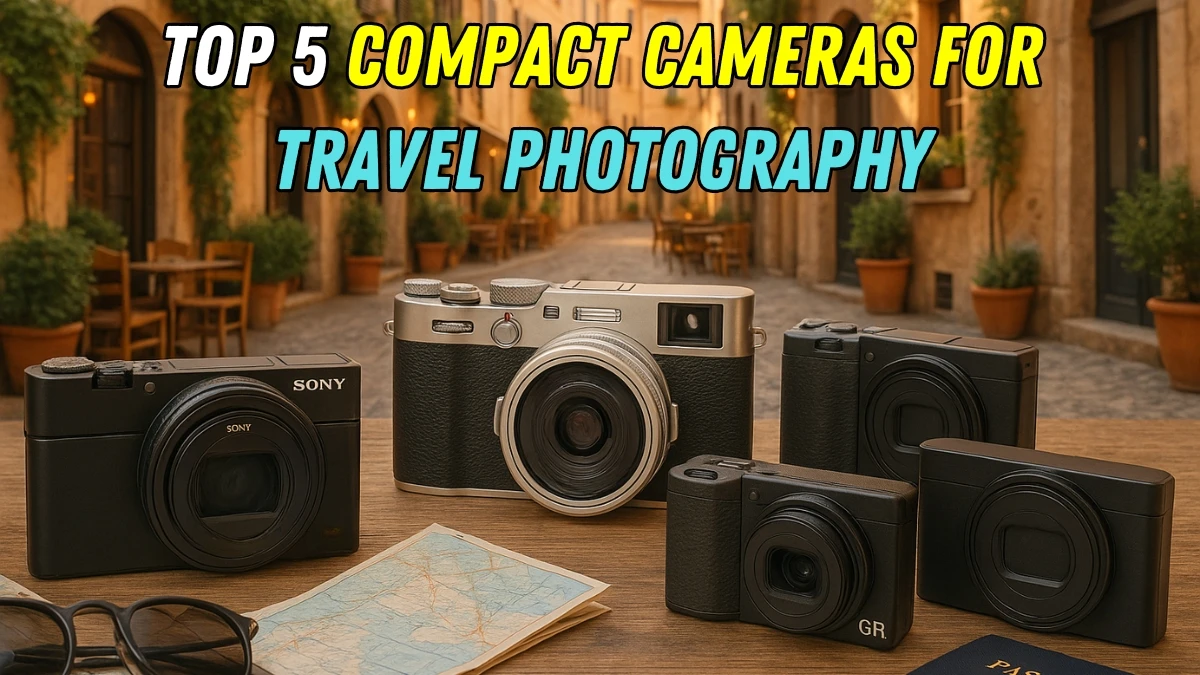Top 5 Best Small Digital Cameras for Travel Photography in 2025
When it comes to travel photography, having a camera that combines portability, power, and high-quality imaging is essential. In 2025, a range of small digital cameras offers incredible versatility, allowing photographers to capture everything from stunning landscapes to intimate street portraits while keeping their gear light and manageable.
Whether you're an avid traveler, an influencer, or simply someone who loves capturing moments, these top 5 small digital cameras provide the perfect blend of ease of use, exceptional image quality, and convenient features.
Here are the best options for your next adventure.
| Rank | Camera |
| 5 | Sony a7C R |
| 4 | Canon PowerShot G7 X Mark III |
| 3 | Ricoh GR IIIx |
| 2 | Fujifilm X100VI |
| 1 | Sony RX100 VII |
5. Sony a7C R

The Sony a7C R pushes the boundaries of what constitutes a "compact" camera by squeezing a professional 61-megapixel full-frame sensor into the smallest possible body. While larger than traditional compact cameras, it offers the ultimate in image quality for travelers who prioritize results above all else.
Technical Specifications:
- Sensor: 61MP full-frame CMOS sensor
- Mount: Sony FE mount (interchangeable lenses)
- Dimensions: 124 x 71 x 60mm (body only)
- Weight: 515g (body only)
- Price Range: $3,000-3,500 (body only)
Full-Frame Excellence in Compact Form
The a7C R's 61-megapixel sensor delivers resolution that rivals medium format cameras while maintaining the dynamic range and low-light advantages of full-frame sensors.
This translates to unprecedented detail capture for travel documentation, with sufficient resolution for large prints or significant cropping while maintaining quality.
The camera's compact dimensions represent a remarkable engineering achievement for full-frame systems.
While certainly larger than fixed-lens compact cameras, the a7C R remains smaller than traditional DSLRs and many mirrorless alternatives, making it viable for travel use when paired with appropriate lenses.
Sony's extensive FE lens lineup provides unmatched flexibility for travel photography.
From ultra-wide angle lenses for dramatic landscapes to telephoto options for wildlife, the system covers every conceivable photographic need. Compact options like the 28-60mm kit lens maintain the system's travel-friendly character.
The autofocus system represents current industry leadership with 693 phase-detection points covering 93% of the frame.
Real-time subject recognition for humans, animals, and birds ensures consistently sharp results, while advanced tracking algorithms maintain focus even with erratic subject movement.
Professional Performance
Image quality from the 61MP sensor sets professional standards. The full-frame sensor's larger photosites capture more light per pixel than smaller formats, resulting in exceptional dynamic range and low-light performance. ISO performance remains clean through ISO 12,800 with usable results extending much higher.
In-body image stabilization provides up to 5 stops of shake correction across five axes. This enables handheld shooting at surprisingly slow shutter speeds, essential for travel photography when tripods aren't practical or permitted.
Battery life at 540 shots per charge significantly exceeds most compact cameras, reducing power management anxiety during long shooting days. The camera's USB-C charging and power delivery support enable charging from portable power banks.
Considerations for Travel
The camera's higher price point places it firmly in professional territory, potentially exceeding many travelers' budgets. When combined with quality lenses, the system cost can approach $5,000 or more.
While compact for full-frame standards, the camera becomes significantly larger when paired with lenses. Even compact options like the 28-60mm kit lens result in a package considerably larger than traditional compact cameras.
The camera's advanced feature set may overwhelm beginning photographers. The extensive customization options and professional controls require investment in learning time to maximize the system's potential.
Perfect For:
- Serious travel photographers prioritizing ultimate image quality
- Professional photographers needing compact full-frame capability
- Anyone requiring interchangeable lens flexibility
- Travelers who print large or crop extensively
4. Canon PowerShot G7 X Mark III

The Canon PowerShot G7 X Mark III proves that excellent travel photography doesn't require breaking the bank. This camera delivers impressive capability and modern features at a price point that makes it accessible to a broader range of travelers, all while maintaining the compact form factor essential for travel use.
Technical Specifications:
- Sensor: 20.1MP 1-inch stacked CMOS sensor
- Lens: 24-100mm f/1.8-2.8 zoom
- Dimensions: 105 x 61 x 42mm
- Weight: 304g (including battery and card)
- Price Range: $600-750
Value-Packed Performance
The G7 X Mark III's 24-100mm zoom range covers the most commonly used focal lengths for travel photography.
From wide-angle landscape shots to portrait-length images, this 4.2x zoom provides sufficient versatility for most travel scenarios without the complexity or cost of interchangeable lenses.
The lens's bright f/1.8-2.8 aperture throughout the zoom range represents exceptional value.
Many zoom lenses sacrifice aperture speed for focal length coverage, but Canon maintains relatively fast speeds that enable better low-light performance and background blur capabilities.
Canon has positioned this camera squarely at content creators with features like live streaming capability to YouTube and a flip-up touchscreen perfect for selfies and vlogs.
The camera can stream directly to social media platforms via Wi-Fi, eliminating the need for separate capture devices or complex setups.
The customizable control ring around the lens allows assignment of frequently used functions like aperture, shutter speed, ISO, or manual focus.
This provides direct access to key settings without diving into menu systems, significantly improving the user experience during active shooting.
Real-World Capabilities
Image quality from the 1-inch sensor provides a significant step up from smartphone cameras while remaining more approachable than larger, more complex systems.
Colors render pleasantly with Canon's traditional warm color science, and the camera handles high-contrast situations reasonably well.
The autofocus system, while not as sophisticated as premium options, performs reliably for typical travel photography scenarios.
Face detection works well for people photography, and the camera tracks moving subjects adequately for casual use.
Video recording reaches 4K resolution with reasonable stabilization, making this camera suitable for travel vlogs and video documentation.
The flip-up screen facilitates self-recording, while the live streaming features appeal to content creators sharing their travels in real-time.
Battery life at 265 shots per charge falls into the typical range for compact cameras. The inclusion of USB-C charging provides modern convenience and compatibility with common travel chargers.
Considerations
The autofocus system, while functional, lacks the speed and sophistication of more expensive alternatives. In challenging lighting or with fast-moving subjects, you may experience occasional focus hunting or missed shots.
Build quality feels solid but not premium, with more plastic construction compared to higher-end alternatives. The camera lacks weather sealing, requiring careful handling in adverse conditions.
Manual control options, while present, don't match the extensive customization available in enthusiast-focused cameras. Photographers transitioning from manual-heavy systems may find the interface limiting.
Ideal For:
- Budget-conscious travelers seeking quality results
- Beginning photographers stepping up from smartphones
- Content creators needing affordable video capabilities
- Anyone wanting versatile zoom range without complexity
3. Ricoh GR IIIx

The Ricoh GR IIIx achieves something remarkable in the camera world: it packs an APS-C sensor into a body smaller than most smartphones. This ultra-compact camera represents the ultimate in portability without sacrificing image quality, making it the perfect always-carry travel companion.
Technical Specifications:
- Sensor: 24.2MP APS-C CMOS sensor
- Lens: 26.1mm f/2.8 (40mm equivalent) fixed focal length
- Dimensions: 109 x 62 x 35mm
- Weight: 262g (including battery and card)
- Price Range: $900-1,100
Ultra-Compact Champion
The GR IIIx's dimensions seem impossible given its APS-C sensor size. At just 35mm thick, it genuinely disappears into any pocket, making it the most portable serious camera available.
This size advantage translates into real-world benefits—you'll actually carry it everywhere, increasing your chances of capturing unexpected moments.
The 40mm equivalent focal length (26.1mm actual) provides a classic "standard" perspective that works beautifully for street photography, environmental portraits, and travel documentation.
This focal length feels natural to the human eye while providing enough wide-angle coverage for most scenarios.
Ricoh's snap focus mode sets the GR IIIx apart from other compact cameras. This feature allows you to preset a focus distance (typically 2.5 meters) and aperture (usually f/5.6 or f/8) for instant shooting without autofocus delays.
Combined with zone focusing principles, this enables incredibly fast, discrete photography perfect for street work and candid travel moments.
The three-axis sensor-shift image stabilization compensates for camera shake across a wider range of shutter speeds than optical stabilization systems.
This proves particularly valuable given the camera's small size, which can be challenging to hold steady.
Real-World Performance
Image quality rivals cameras many times larger thanks to the APS-C sensor. Colors render naturally with pleasing skin tones, while the camera's computational photography features enhance dynamic range and shadow detail. The lens, while modest on paper at f/2.8, delivers sharp results across the frame with minimal distortion.
The camera's discrete operation makes it ideal for travel photography where you want to blend in. The silent electronic shutter option eliminates all camera noise, while the compact size draws minimal attention from subjects or bystanders.
Startup time impressively fast at just one second from power-on to first shot. Combined with the snap focus mode, this creates a camera capable of capturing fleeting moments that larger cameras would miss due to operational delays.
Limitations to Consider
Battery life at approximately 200 shots represents the camera's most significant limitation. The tiny battery pack necessitates carrying multiple spares for serious shooting sessions.
The camera lacks weather sealing, requiring extra care in challenging conditions.
The fixed 40mm focal length, while versatile, occasionally feels limiting. You'll find situations where you want wider coverage for landscapes or longer reach for distant subjects.
The lack of a viewfinder means relying entirely on the rear LCD, which can be challenging in bright sunlight.
Video capabilities remain basic compared to other cameras in this roundup, with 1080p recording and limited advanced features. This camera clearly prioritizes still photography over video creation.
Perfect For:
- Minimalist travelers prioritizing ultimate portability
- Street photography enthusiasts
- Anyone wanting the smallest possible high-quality camera
- Photographers who value discrete operation
2. Fujifilm X100VI

The Fujifilm X100VI represents the perfect marriage of classic camera aesthetics and cutting-edge technology.
This latest iteration of Fujifilm's beloved X100 series delivers the highest image quality available in a compact camera while maintaining the timeless design that has made these cameras cultural icons.
Technical Specifications:
- Sensor: 40.2MP APS-C X-Trans CMOS 5 HR sensor
- Lens: 23mm f/2.0 (35mm equivalent) fixed focal length
- Dimensions: 128 x 75 x 55mm
- Weight: 521g (including battery and card)
- Price Range: $1,600-1,800
The Game-Changing Appeal
The X100VI's 40.2-megapixel APS-C sensor delivers image quality that rivals full-frame cameras from just a few years ago.
The larger sensor size compared to 1-inch alternatives provides superior low-light performance, better dynamic range, and more natural background blur—crucial advantages for travel photography.
The fixed 23mm f/2.0 lens (35mm equivalent) hits the sweet spot for travel photography. This focal length captures environmental context while remaining intimate enough for street photography and portraits.
The fast f/2.0 aperture enables beautiful background separation and excellent low-light performance.
Fujifilm's legendary color science shines through the camera's film simulation modes, offering 20 different looks that can transform your images straight out of camera.
These simulations, from classic Velvia saturation to modern Eterna cinema tones, reduce post-processing time and help establish a consistent aesthetic for your travel documentation.
The hybrid viewfinder system unique to the X100 series allows switching between optical and electronic viewing. The optical viewfinder provides a natural, lag-free view of the world with frame lines indicating your composition, while the electronic viewfinder offers precise framing and real-time exposure preview.
Real-World Excellence
Image quality from the X100VI sets the standard for compact cameras. The APS-C sensor's larger photosites capture more light per pixel than smaller formats, resulting in cleaner high-ISO performance and greater dynamic range.
This translates to more forgiving exposure latitude and better shadow/highlight recovery in post-processing.
The camera's weather-sealing provides confidence when shooting in challenging conditions. While not submersible, the dust and splash resistance handles typical travel scenarios like light rain, beach environments, or dusty conditions.
Battery life at 450 shots per charge significantly exceeds most compact cameras, reducing anxiety about power management during long shooting days.
The mechanical shutter also operates silently when needed, perfect for discrete street photography or quiet environments like museums.
Considerations
The fixed 23mm focal length represents both a strength and limitation. While 35mm equivalent proves versatile for most travel photography, you'll occasionally wish for wider or longer perspectives.
Fujifilm includes digital crop modes (50mm and 70mm equivalents) that maintain reasonable image quality, though they reduce resolution.
The camera's popularity has created availability challenges, with waiting lists common at many retailers.
The premium price point also places it above many travelers' budgets, though the image quality and build quality justify the investment for serious photographers.
Ideal For:
- Street photography enthusiasts
- Travelers who appreciate classic camera aesthetics
- Photographers prioritizing maximum image quality
- Anyone seeking discrete, high-quality documentation
1. Sony RX100 VII

The Sony RX100 VII stands as the pinnacle of compact camera engineering, representing years of refinement in Sony's acclaimed RX100 series.
This powerhouse packs professional-level features into a body that truly fits in your palm, making it the go-to choice for travelers who refuse to compromise on capability.
Technical Specifications:
- Sensor: 20.1MP 1-inch stacked CMOS sensor
- Lens: 24-200mm f/2.8-4.5 (8.3x optical zoom)
- Dimensions: 102 x 58 x 43mm
- Weight: 302g (including battery and card)
- Price Range: $1,200-1,400
Why It Excels for Travel Photography?
The RX100 VII's greatest strength lies in its incredible versatility. The 24-200mm zoom range covers virtually every travel photography scenario you'll encounter—from sweeping landscape vistas at 24mm to distant architectural details or wildlife at 200mm.
This eliminates the need to carry multiple lenses or constantly move closer to subjects, a significant advantage when traveling.
The pop-up electronic viewfinder proves invaluable for shooting in bright daylight conditions where LCD screens become difficult to see.
Unlike many compact cameras that rely solely on rear screens, the RX100 VII's 2.36-million-dot OLED viewfinder provides a clear, detailed view of your composition even under harsh sunlight.
Perhaps most impressively, the camera's 90fps burst mode with continuous autofocus can capture action sequences that would challenge even professional sports cameras.
While this extreme speed requires specific lens settings, the standard 20fps burst mode works flawlessly for everyday travel photography, ensuring you never miss decisive moments.
Real-World Performance
Image quality from the 1-inch sensor rivals many APS-C cameras, particularly when shooting in good light. The sensor's stacked design enables incredibly fast readout speeds, virtually eliminating rolling shutter effects that plague many compact cameras when shooting moving subjects.
The autofocus system represents the current state-of-the-art for compact cameras, with 357 phase-detection points covering 68% of the frame.
Real-time eye detection works reliably for both humans and animals, while subject tracking maintains focus even when your subject moves erratically through the frame.
Low-light performance impresses up to ISO 3200, with usable results extending to ISO 6400 when necessary.
The combination of optical image stabilization and the bright f/2.8 aperture at wide angles allows for handheld shooting in challenging lighting conditions.
The main limitation remains battery life at just 260 shots per charge. This necessitates carrying spare batteries for full-day shooting, though the camera's USB charging capability allows for convenient charging from power banks during travel.
Best Suited For:
- Travelers seeking maximum versatility in minimal space
- Wildlife and street photography enthusiasts
- Content creators requiring professional video capabilities
- Anyone wanting a single camera solution for diverse shooting scenarios
Quick Comparison Guide
| Camera | Price | Sensor Size | Weight | Battery Life |
|---|---|---|---|---|
| Sony RX100 VII | $1,200-1,400 | 1-inch | 302g | 260 shots |
| Fujifilm X100VI | $1,600-1,800 | APS-C | 521g | 450 shots |
| Ricoh GR IIIx | $900-1,100 | APS-C | 262g | 200 shots |
| Canon G7 X III | $600-750 | 1-inch | 304g | 265 shots |
| Sony a7C R | $3,000-3,500 | Full-frame | 515g | 540 shots |
What Makes a Great Travel Camera in 2025?
Size and Weight remain paramount considerations. A true travel camera should fit comfortably in a jacket pocket or small bag without creating bulk or weight that you'll notice during long walking days. If you find yourself leaving the camera behind because it's too cumbersome, even the best image quality becomes meaningless.
Image Quality has become the great equalizer in 2025. Modern compact cameras feature large sensors—typically APS-C or 1-inch formats—that capture significantly more light and detail than smartphone sensors. This translates to better low-light performance, superior dynamic range, and the ability to create professional-looking images with natural background blur.
Battery Life can make or break a travel photography experience. Nothing is more frustrating than missing a perfect sunset or spontaneous moment because your camera died. The best travel cameras offer enough power for a full day of shooting, though carrying spare batteries remains wise for extended adventures.
Build Quality and Weather Resistance become crucial when traveling to diverse environments. Your camera needs to withstand varying temperatures, humidity, dust, and occasional splashes. While not every compact camera offers full weather sealing, the best models provide enough protection for typical travel conditions.
Ease of Use cannot be understated when you're navigating unfamiliar locations or capturing fleeting moments. Intuitive controls, responsive autofocus, and quick startup times ensure you never miss the shot while fumbling with settings.
Connectivity Features like Wi-Fi and Bluetooth have become essential for modern travelers. The ability to instantly transfer images to your smartphone for sharing, backing up photos to cloud storage, or controlling the camera remotely opens up creative possibilities and provides peace of mind.
Video Capabilities round out the modern travel camera requirements. Even if you're primarily a stills photographer, having quality 4K video recording capability means you can capture moving memories and expand your creative storytelling options.
The 2025 landscape has brought significant technological advances that benefit travel photographers. Computational photography now enhances image quality through AI-powered processing, while improved low-light performance means you can capture stunning images well into blue hour and beyond.
Faster, more intelligent autofocus systems with subject recognition ensure sharp photos of people, animals, and vehicles, while enhanced stabilization systems—both optical and in-body—allow for sharp handheld shots in challenging conditions.
Essential Buying Guide and Travel Tips
Choosing Your Budget Range
For travelers spending under $800, the Canon PowerShot G7 X Mark III represents the best value, offering solid image quality and versatile zoom range without premium pricing. Used Sony RX100 models from earlier generations also provide excellent alternatives in this price range.
In the $800-1,200 range, both the Ricoh GR IIIx and used Sony RX100 VII models become available. The choice depends on your priorities: maximum portability (Ricoh) versus zoom versatility (Sony).
The $1,200-1,800 premium range includes the Sony RX100 VII and Fujifilm X100VI, representing the current pinnacle of compact camera technology. Your choice depends on whether you prioritize zoom versatility or maximum image quality.
Above $3,000, the Sony a7C R enters professional territory with full-frame performance, though lens costs significantly increase the total system investment.
Essential Travel Accessories
Extra batteries prove critical for all compact cameras due to their small battery capacities. Plan on carrying at least two spare batteries for full-day shooting, with three recommended for extended adventures without charging opportunities.
High-speed memory cards become essential for 4K video recording and rapid burst photography. Look for cards rated V30 or higher to avoid recording interruptions or buffer limitations.
Protective cases provide crucial protection for expensive camera gear during travel. Consider both hard cases for checked luggage protection and soft pouches for daily carry and weather protection.
Lens cleaning supplies remain essential when traveling to dusty or sandy environments. A basic kit with lens tissue, cleaning solution, and a blower keeps your camera performing optimally in challenging conditions.
Portable USB power banks extend shooting capability when electrical outlets aren't available.
Look for models supporting your camera's specific charging requirements, with USB-C becoming increasingly common.
Disclaimer:
The information provided in this article is based on publicly available data and expert reviews as of 2025. Camera prices, specifications, and features may change over time due to product updates or market conditions. For the most accurate and up-to-date details, please refer to official manufacturer websites and trusted retailers.






